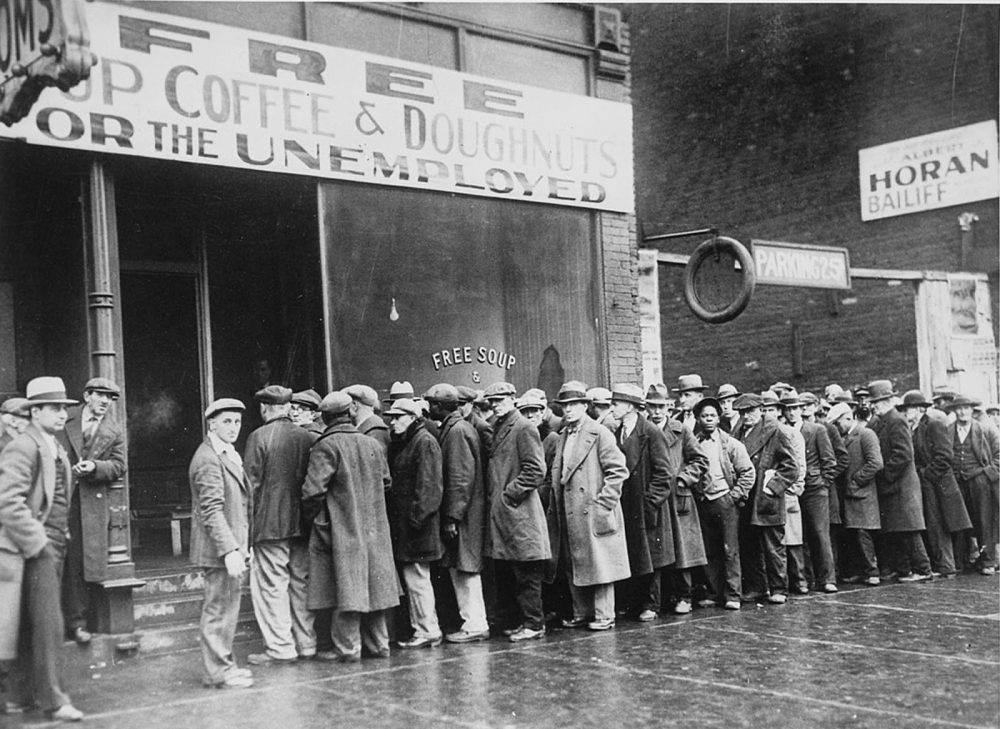
SAVR KUMAR – MARCH 12TH, 2020
EDITORS: RAINA ZHAO, PARMITA DAS
The question of whether the next global depression is due is a fascinating, albeit worrisome, one. While speculation and accompanying fear around the next recession spiked in 2018 and early 2019, the attention on the topic has reached a relative lull, as the public and media focus on more immediate news such as that of the coronavirus, upcoming US elections, and political unrest around the world. Discussing the possibility of another recession is not any less necessary, however, especially considering the fact that events like these are inextricably tied to the global economy.
The global volume of negative-yielding debt is now 17 trillion dollars. Forbes economist Martin Fridson suggests that the argument that bond investors will make losses at some point in the future is an obvious one. According to him, the eventual rebound of the interest rate that will cause those losses will be followed by a recession. Some of the questions we must ponder include when this potential recession might be, what commonalities are present between the potentially upcoming recession and previous ones, and how government actions might mitigate or exacerbate it.
Let’s begin by discussing the US economy, the world’s largest economy since 1871. Most, if not all, global financial crises in history have been inextricably connected to the United States, from the 2008 recession to the Great Depression of the 20th century. The US economy’s expansion invariably affects the world economy’s growth. As of July 1st, 2019, the US economy has reached the longest expansion in US history. Part of the reason why speculation about the next recession may have decreased is due to the persistence of this expansion; the third quarter of 2019 beat market expectations and lengthened the period of expansion, which began roughly a decade ago.
However, many speculate that a global depression is fairly likely for reasons such as the mounting debt and the United States’ lack of preparation for a possible recession. Financial writer and author John Mauldin suggests that we must focus on the vulnerabilities of the American economy. The United States has a deficit that is already running a trillion dollars, that could “‘easily’ be running a trillion five, a trillion six” during a recession, when automatic stabilisers kick in. There will be a decline in revenue and increased spending, culminating in a 7 to 8% deficit in the GDP. Fiscal irresponsibility may create a dollar crisis which could affect economies around the world.
According to Ryan Avent, a senior editor at the Economist, warning signs have appeared from the mid-2010s onward, but economic vulnerabilities such as those mentioned by Mauldin (like the massive US current account deficit and substantial global value of debt) aren’t quite as large as during the 2008 crisis. All the same, these vulnerabilities are significant enough that we could see a slowdown in GDP growth and trade. He purports that the real risk is the lack of preparedness and the lack of room for global cooperation. These may initially lead to a minor downturn at first, but may turn into something much larger and more difficult to deal with. Thus, Avent’s perspective is that, although the next recession is likely, its scale will likely be smaller due to the fact that the vulnerabilities are different. However, his predictions do not take into account complexities such as the emergence of the coronavirus and the ever-increasing stakes of the trade war.
Where the financial crisis will begin is also likely to be different. The last big financial downturn was in the US with the collapse of the housing bubble. The next financial crisis may start somewhere in the emerging world, in economies like India and China. These economies possess a much larger share of the global output than they used to, and have also gone on a ‘borrowing binge’ over the last 10 years, which could be due for a reckoning. According to the Institute of International Finance, as a result of monetary easing by the central banks in emerging economies, there have been lower borrowing costs which encouraged emerging economies to take on new debt. Sonja Gibbs, the IIF’s managing director for global policy initiatives suggests that once rates go back up, debts are hard to pay down without compromising on other important objectives such as productive investment within a country. In dollar terms, the combined debts of 30 of the largest emerging economies rose to over 69 trillion dollars in 2019.
There are also reasons to be concerned about the Eurozone, particularly Italy which has an enormous debt problem. The market has been slightly jittery about Italy’s ability to pay back its debts, which could relaunch the Eurozone debt crisis from 5 years ago. A debt crisis is a situation when a government, due to a prolonged period of its spending exceeding its revenue, loses the ability to pay back its debts. Many debt crises in the past, such as Germany’s debt crisis after the First World War, had serious ramifications for the global economy. This is because one country’s inability to pay back a large debt usually means that other economies, or organizations such as the IMF, must help bail them out.
Raghuram Rajan, former RBI governor of India, agrees that much of the growth in global trade is tied to emerging markets. He discusses a different set of vulnerabilities that he feels will most likely shape the upcoming crisis. One such vulnerability is the leverage that has built up across the globe, not just in flows to emerging markets but also within industrial countries. Leverage can refer to the amount of debt that a firm makes use of to finance its assets. It also refers to the investment strategy of using borrowed money to increase potential return on investment. Fast growing pockets of debt include examples such as American student loan debt (roughly 1.5 trillion). Other sectors that have become very highly leveraged include the housing sector in Australia, and the shale industry in the US. Similar pockets of leverage were present preceding the 2008 crisis. As debt grew in the mortgage market preceding the 2008 crisis, a housing bubble was created as more and more people would borrow money to purchase houses that were skyrocketing in price. Eventually, when no one could pay for these houses, the bubble burst, which led to the 2008 financial crisis.
On top of all this, interest rates have been rising. The Federal Reserve will likely continue raising interest rates as the US employment rate is rising and inflation is picking up. The last time the Fed raised rates, the US economy was doing well and was accepting exports from Asian markets. Now, the Fed is faced with a different US economy—one with a strong dollar and higher interest rates, but limitations on Asian exports due to increasing trade barriers from the current US-China trade war. Thus, there is a greater degree of uncertainty.
There are numerous economists who, on the other hand, argue that a great recession is not coming any time soon. Yuwa Hedrick-Wong, an ex-economist at Mastercard and current faculty at the National University of Singapore, approaches the topic from the perspective of the Chinese economy. He states that beliefs about China’s slowing economy is more myth than reality. Although China’s real GDP growth peaked in 2007 at 14.2% and has been trending downward since, Hedrick-Wong argues that the decreasing growth rates would be perfectly acceptable if the Chinese economy continues to grow around 6-7% in real terms. He says that it is not necessary or desirable to maintain that unmatchable level of growth. He acknowledges that other factors, such as the decline of the Chinese stock market, signal that the slowing Chinese economy is being affected by the trade war. However, he concludes that, unlike the US, China’s stock market has few substantial links with the rest of the economy.
Furthermore, Hedrick-Wong believes that since China dealt with a worse debt situation in the 1990s, it can do so again. He takes contrasting stance to that of Raghuram Rajan and Ryan Avent, suggesting that a high level of debt by itself is not a problem if it is productively invested. He believes that the best solution to China’s debt overhang is, therefore, to gradually increase productively invested debt. He concludes that the emphasis on deleveraging is more exaggerated than need be; he opposes the idea that the recession is coming and that economies like that of China are vulnerable.
Ray Dalio from Bridgewater Associates suggests that the problem with debt is that most countries do not have debt denominated in their own currency. He thinks that the significance of debt has less to do with the direct economic vulnerabilities it poses, but with the political implications. He states that our current period is very similar to the period around 1935-1940. From 1929 to 1932, we experienced a debt crisis amidst the Great Depression and interest rates hit zero. A similar debt crisis took place in the period from 2000 to 2007. In these situations, central banks buy money and print financial assets, pushing financial assets up, injecting liquidity, and contributing to a greater wealth gap. As a result of this widening wealth gap, in both periods of time, populism tended to come to the forefront. The economic consequences of such policies are uncertain but asset prices are sensitive to changes in monetary policy. Ray’s argument is similar to Raghuram Rajans’ in that it focuses more on the political shock that may impede the progress of the global economy. Governments printing a lot of money and investing in financial assets may contribute to an increasing wealth gap, which may add to the impetus of the recession. When there are huge disparities in income, the middle and lower classes are particularly vulnerable to economic shocks.
In any case, if a recession does strike, shaky governance will only exacerbate the situation. According to Avent, there are numerous obstacles to government officials reaching a consensus and taking action to counteract a financial crisis at both the national and multilateral levels. Within countries, governments have become much more polarized, while across the world there has been an increase in populist and nationalist parties. This may make it harder to reach the much-needed agreement to launch big spending programmes, or other legislation of that nature. Ultra-nationalist leaders tend to have incendiary rhetoric and many, over the course of history, have found isolationist policies appealing to their political agenda. Rivalries between countries also make it likely that there will be contentious policies such as increases in tariffs or currency and trade wars. Avent believes a recession is not inevitable and attempts can be made to avoid it. There are concerns from other economists, however, that these attempts may not work.
The tools governments usually use to fight a recession won’t be available to combat a forthcoming recession. Central banks usually cut interest rates to stimulate spending and growth to curtail recessions, but they may not be able to do so since the interest rates are currently very low. Avent suggests governments may have to resort to less-tested methods such as quantitative easing, or printing money to buy bonds. Quantitative easing was utilized in the last recession, and works in a much more uncertain way.
According to Avent, governments should be modifying their central bank targets, and preparing their budgets to include measures that increase spending automatically should the economy weaken. Doing so proactively would help avoid legislative fights regarding whether to expand spending when the time comes. Most importantly, governments should coordinate their actions with each other in order to avoid a recession. According to him, these measures would deter a repeat of the 1930s, when tariff barriers went up and spiked currency wars and competitive devaluations. Geopolitical tension has the potential to produce a self-reinforcing cycle of hostility, trade wars, and diplomatic strain. Although it may seem premature to discuss governmental response to a recession that may or may not occur, it is crucial to consider which economic policies governments should employ in response to a possible downturn.
The reasons put forth for the imminent occurrence of the next global recession include highly leveraged industries in countries from the US to Australia, similarity to problems that caused the 2008 crisis, and vulnerabilities of various kinds in countries such as Italy and China. On the other hand, counterarguments posit that China’s slowdown in trade is overemphasized, that the US economy’s expansion may continue its trend of growth, and that debt is not as threatening of a problem as it’s made out to be.
It is questionable whether arguments such as those made by Yuwa Hedrick Wong entirely negate the worries of those who predict a financial crisis. While economists such as Ragan and Avent focus on discussing the vulnerabilities that exist, Wong shows that these vulnerabilities do not necessitate disaster. The situation, however, continues to change and is ostensibly unpredictable such that events such as the Coronavirus outbreak may catapult the economy into recession. Due to these previously unforeseen factors and the precarious position of the global economy, it is difficult to predict with certainty whether a recession is imminent. Signs indicate that a recession is certainly possible and that it may be exacerbated without the right preventative multilateral actions from governments around the world.
Featured Image Source: pbs
Disclaimer: The views published in this journal are those of the individual authors or speakers and do not necessarily reflect the position or policy of Berkeley Economic Review staff, the Undergraduate Economics Association, the UC Berkeley Economics Department and faculty, or the University of California, Berkeley in general.



